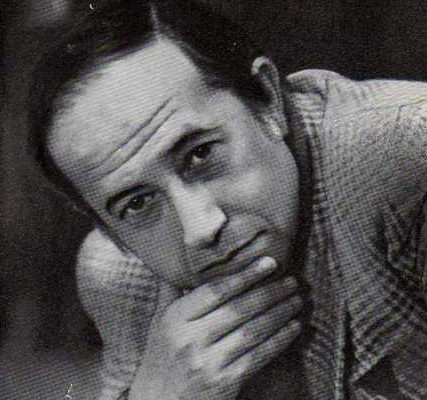
Romualds Grīnblats
(11.04.1930 - 14.08.1995 )
Romualds Grīnblats was born on April 11, 1930, in Kalinin, Russia, the son of the doctor Samuils Grīnblats and his wife, Sara (née Buncis). He began playing music around the age of fifteen, and, having swiftly developed his skill at playing the piano, he also turned to composition. From 1946 until 1950, Grīnblats studied composition under Sergei Wolfensohn, and later under Orest Yevlakhov, at the Leningrad (now Saint Petersburg) Conservatory’s music school. While a student, he composed short works for piano and romances.
Grīnblats moved to Latvia in 1950 and enrolled in the Latvian State Conservatory, where he studied composition under Ādolfs Ābele. He was inspired by the music of Dmitri Shostakovich and Sergei Prokofiev, and this music also influenced Grīnblats’ own style as a composer. He wrote instrumental miniatures, a piano quintet on the theme of peace, the song cycle "Pasaules dzejnieki cīņā par mieru" ("Poets of the World in Battle for Peace") and graduated from the conservatory with his Symphony No. 1 in E minor.
After finishing his studies in 1955, Grīnblats began working at Latvian Radio as a sound engineer. He also worked in the music department of the Latvian State Publishing House from 1957 to 1961.
Grīnblats’ ballet "Rigonda", which premiered on September 12, 1959, earned considerable recognition. It was choreographed by Helēna Tangijeva-Birzniece and conducted by Jānis Hunhens, with set design by Edgars Vārdaunis and costumes by Biruta Goģe. For inspiration, Grīnblats had turned to the Leningrad Museum of Ethnography, where he examined the materials about Polynesian culture. Following the premiere, musicologist Ligita Viduleja and composer Marģeris Zariņš praised the creators’ ability to refrain from excessive detail, speak in a contemporary language and reach an unprecedented level of originality in the context of Latvian ballet. The stage truly became an exotic South Sea island, and the imagination and innovation of Vārdaunis’ sets (the dancers performed on a raked stage, and the floor covering was also unconventional) matched Tangijeva-Birzniece’s skill at avoiding the canons of classical ballet. At the time, Grīnblats was considered a positive character among the progressive forces in Soviet Latvia and was feted as a promising composer of music for the stage. Rigonda’s creators received the State Prize of the Latvian SSR. In 1960, the ballet was performed in Tallinn and Vilnius.
In 1962, Grīnblats received third prize at the All-Union Young Composers’ Review in Moscow.
Grīnblats composed very many works for the theatre and cinema. His most famous and beloved works are the music for the Jaunatnes teātris (Youth Theatre) productions "Tils Pūcesspieģelis" (Till Eulenspiegel), "Zaļais putniņš" (The Little Green Bird), "Pāvilielas zēni" (The Boys of Pāvils Street) and "Pīters Pens" (Peter Pan), but he also worked with the Drama Theatre and the Russian Drama Theatre in Riga. He wrote music for nine films.
Grīnblats composed six symphonies, a concerto for piano and orchestra, Jaunatnes uvertīra (Overture of Youth), Pionieru svīta (Pioneers’ Suite), the Balāde (Ballad) choreographic poem and the Daugava poem. Of particular note is his Concerto for flute and chamber orchestra, premiered by flutist Vilnis Strautiņš and conductor Leonīds Vīgners. It is one of the finest later-20 th -century concertos by a Latvian composer and also one of the rare works written in the twelve-tone technique. While employing this seemingly bare, mathematical technique, the unusually talented Grīnblats revealed poetic, even transcendental, worlds hidden behind the transparent sound of the Flute Concerto. Music critic Armands Znotiņš wrote: “Grīnblats’ abilities in the Flute Concerto are quite admirable, creating emotionally intense and saturated music based on an impeccable mastery of the mathematical principles of the twelve-tone technique that astonishes in terms of the rational parameters of the composition’s structure as well as the emotions incorporated within the music. What also amazes is the composer’s talent for conjuring an artistic landscape that contains both impulsive contrasts and poetic enlacements of tones as well as a diverse play of rhythms, timbres and harmonies – between the flute and orchestra as well as within the string group itself – and unpredictable curves in the development of the cycle’s musical form. No less exciting in this concerto was to hear not only the undeniable kinship between Grīnblats’ musical art and the Western avantgarde, but also his similarity to certain characteristics of the work of Harry Partch and Conlan Nancarrow, because Grīnblats most certainly did not know of the existence of these composers, who were quite unknown during his lifetime” (Diena; March 15, 2012).
Grīnblats also composed in the genres of instrumental chamber music, vocal chamber music and vocal-instrumental music. His style contains a variety of elements; his melodies are unique and supple, his rhythm strict and definite, his harmony conformed to the personality of each particular character.
Grīnblats moved to Leningrad (Saint Petersburg) in 1971, where he worked as an editor for a music publisher. It was also there that he died on August 14, 1995.
